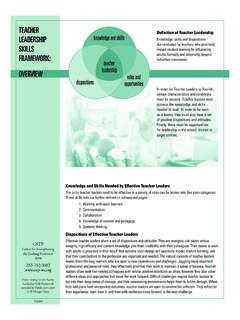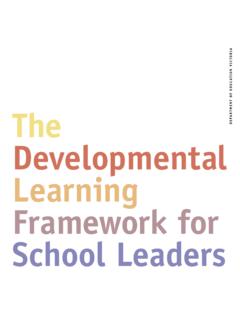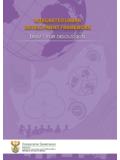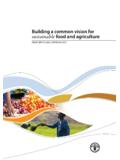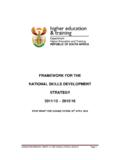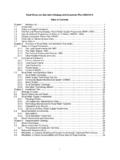Transcription of Rural 3.0. - oecd.org
1 Rural notea framework for Rural development ABOUT This Policy Note shares the OECD s Rural Policy a framework to help national governments support Rural economic development. The New Rural Paradigm, endorsed in 2006 by OECD member countries, proposed a conceptual framework that positioned Rural policy as an investment strategy to promote competitiveness in Rural territories. This approach represented a radical departure from the typical subsidy programmes of the past that were aimed at specific sectors.
2 Rural Policy is an extension and a refinement of this Paradigm. Where the New Rural Paradigm provided a conceptual framework , the Rural Policy focuses on identifying more specific mechanisms for the implementation of effective Rural policies and practices. For more information: Forllow us on Twitter: @OECD_local #OECD Rural OECD 2018 This work is published under the responsibility of the Secretary-General of the OECD. The opinions expressed and arguments employed herein do not necessarily reflect the official views of the Organisation or of the governments of its member countries.
3 This document and any map included herein are without prejudice to the status of or sovereignty over any territory, to the delimitation of international frontiers and boundaries and to the name of any territory, city or area. 3 CONTENTS INTRODUCTION .. 4 MEGA-TRENDS .. 5 Rural REGIONS ARE PLACES OF OPPORTUNITY .. 7 Rural AREAS ARE DIVERSE AND HAVE DISTINCT NEEDS .. 11 PRODUCTIVITY GROWTH IS CRITICAL FOR THE FUTURE OF Rural WELL-BEING .. 14 PARTICIPATION IN GLOBAL MARKETS IS KEY TO REALISING THE GROWTH POTENTIAL OF Rural AREAS.
4 18 THE Rural POLICY A framework FOR ACTION TO ADDRESS CHALLENGES AND OPPORTUNITIES OF THE 21ST CENTURY .. 21 4 INTRODUCTION Rural regions will play a central role in meeting the major global opportunities and challenges of the 21st century. This includes developing new energy sources that meet our climate challenge, innovation in food production for a growing population, and the provision of natural resources that will enable the next production revolution. Some Rural areas are performing well and are in a position to grasp these opportunities.
5 Other Rural regions have not been as successful and have less capacity to adapt. Structural shifts in manufacturing and natural resource based industries combined with population loss and ageing mean some Rural communities are being left behind, which fuels discontent. The capacity of governments to effectively address these challenges and opportunities will impact future national cohesion and prosperity. This policy brief outlines the case for focusing on Rural areas as engines of national prosperity and how policies should leverage this opportunity.
6 It is organised as follows. First, the changing context for Rural policy is assessed in the context of 6 mega-trends that will bring new challenges and opportunities for Rural regions. Second, it shows that Rural regions are not synonymous with decline or agricultural specialisation, but places of growth and opportunity. Third, the distinctiveness and diversity of Rural regions is discussed including how distance, dependence on external markets, and natural resources influence development. Fourth, the importance of increasing productivity in the context of population ageing is outlined along with analysis about the quality of life that Rural regions can offer relative to urban areas.
7 Fifth, it discusses the importance of the tradeable sector and linkages with cities as drivers of growth and how policies can respond to that. The policy brief concludes by presenting the Rural Policy which provides guidance to governments about how to leverage opportunities and position Rural regions for prosperity and well-being. 5 MEGA-TRENDS A number of global shifts are likely to influence how Rural areas can succeed in a more complex, dynamic and challenging environment.
8 In the 21st century successful Rural areas will be outward-looking and engaged in international markets. In order to secure the future prosperity and well-being of Rural places, a number of inter-connected challenges and opportunities will need to be addressed. These mega-trends relate to the impacts of ageing population, urbanisation, the rise of emerging economies, climate change and environmental pressures, increasing globalisation, and technological breakthroughs. Population ageing and migration.
9 The general trend of ageing across OECD economies, which is generally more apparent in Rural regions, is forecast to continue. As consequence, there will be increasing competition for talent. The capacity for Rural communities to provide an attractive offer and integrate newly arrived migrants will shape their capacity to address the challenge of ageing and shrinking populations. Increasing digital connectivity and the shift to a sharing economy may also open up new innovative ways of addressing social challenges that are led by Rural communities.
10 Urbanisation. The trend of people moving from Rural places to metropolitan areas has stabilised in OECD economies. However, population ageing, particularly in Rural remote areas, will tend to shift the political balance within countries toward metropolitan areas. Political discontent may rise among those that felt left behind and not listened too. It will be important that national governments have frameworks and mechanisms to include Rural interests in decision-making, and that those Rural places can foster linkages with cities.










